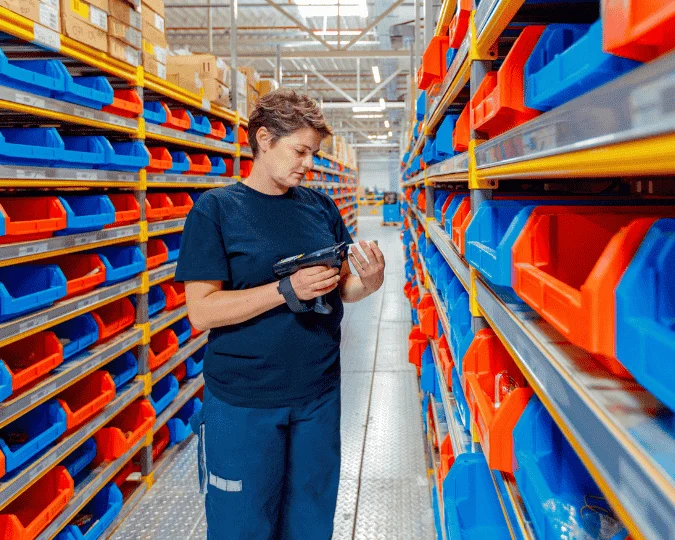The Rising Issues in Inventory Management Today and 7 Tips to Stay Ahead of the Curve

As the world increasingly turns to online shopping and expects more from retailers, effective inventory management is crucial. The need to continuously improve operations is coming into sharper focus. Getting the right amount of merchandise to the right place at the right time requires a proactive approach. Inventory managers must develop best practices to avoid some rising obstacles in the field and stay ahead of competitors.
To help your company get ahead, we’ve compiled a list of some of the most significant inventory problems and solutions.

7 Tips for Overcoming Inventory Planning Challenges
The lack of foresight and strategic planning is one of the most significant factors driving waste and lost sales opportunities in inventory and warehouse management.
Issues with inventory management can have a direct impact on your bottom line. Hidden costs associated with an inefficient use of labor, mistakes and storage costs are costing businesses billions. It can also damage customer relationships in a major way. Some of the most common customer complaints include:
- Received the wrong item
- Not able to order
- Shipping delay
- Added to a waitlist
- Received broken items
Each of these reasons for dissatisfaction can be traced back to inventory management issues in the warehouse. For example, faulty or damaged goods is the reason behind 30% of e-commerce returns. It can happen when warehouse staff doesn’t handle or pack merchandise safely. It can also result when inventory delivered from suppliers isn’t inspected on arrival.
Being unable to order or being placed on a waitlist is a direct result of inventory shortages, which are almost always preventable — and receiving the wrong item can be due to inventory mismanagement.
While shipping delays are often attributed to issues in transportation, fast shipping starts in the warehouse. When orders come in, two factors determine how fast they can be shipped. First, the items need to be available in the warehouse. Second, the sale needs to be processed, and the items need to be packed for the shipment to go out. Four days is the longest 88% of consumers are willing to wait to receive an online order. So, inventory management problems can be costing customer loyalty.
Almost all issues of inventory management that lead to customer complaints and lost revenue can be resolved with better planning, data and inventory management techniques. Here are the top seven emerging issues in inventory control and management for stores and warehouses. We’re here to show you what to do to solve them.
1. Mispicks
Mispicking occurs when the items corresponding to a customer order aren’t picked and packed in the warehouse. Either an item is missing, or a wrong item is included. Usually, mispicked shipments are delivered to customers and have to be exchanged for the correct order. There are many reasons why a mispick occurs. One possibility is when the wrong item looks similar to the ordered item. For example, a warehouse worker might select a navy sweater instead of a dark gray one.
The other possibility is that the warehouse management system has incorrect bin information. If a bin is marked with an SKU of one item, and another is inside, the wrong thing will be picked and packed. A mislabeled container can lead to a systemic picking error. The result will be an influx of customer returns your warehouse may not be prepared for. Further, similar SKUs placed sequentially, such as 374-E and 374-F, can lead to similar human errors.
Some studies estimate the average mispicked delivery costs companies $22. The main cost lies in duplicated shipping costs on the company’s dime. However, other factors can increase that cost. Picking errors in the warehouse bring the customer service department into the fold, costing time and labor. Often, customer service representatives must assist customers through the returns process. Receiving the wrong order can disappoint and anger customers, decreasing the chances that they’ll shop with you again. Couple this with a stressful returns process and every mispick can send another customer to your competitors.
Distribution centers lose an estimated $390,000 per year from mispicks. That figure includes the cost of:
- The replaced item
- Return shipping
- Additional processing
- Returning items to stock
- The loss of customer satisfaction
The best way to combat these costs is by knowing how to stop picking errors. You can reduce mispicks with barcode scanning to verify orders. Finale Inventory’s barcode inventory management solutions create fewer picking errors by directing warehouse runners to the correct location. The scanner prompts them to scan a barcode as they pick each item for shipment. It’s also critical for warehouse workers to log locations as items get stocked. If inventory locations change throughout the warehouse, doing so can prevent incorrect SKU labeling.
It’s also a good idea to create an SKU labeling system that reduces the chances of mistakes. For example, keeping similar SKUs far apart on shelves can reduce misread labels. For items that are often mistaken, you can give similar products unique packaging to minimize confusion.
2. Overstocking
When controlling inventory levels, you need to account for the number of sales you expect to make before your net reorder. You also want to keep a certain amount of safety stock, in case sales spike unexpectedly or you face a delay in your supply chain. Anything above your regular inventory and safety stock is considered overstock.
Overstocking has several causes. First, trying to accurately predict how much stock you need to cover your incoming sales can be near impossible without accurate data. Sales numbers rise and fall from week to week and month to month for all kinds of reasons. It might be easy to predict that you’ll sell fewer snow shovels in March than you did in January. Still, estimating the exact number requires reliable data from the previous year and analysis of the trends from February.
Another cause of overstocking is an inaccurate stock count. One of the challenges of stock-taking is that it’s extremely error-prone. When employees only have a pen, paper and their own eyes to perform a stock take, it’s easy for them to lose their place or miss items on the shelf. When data gets entered into a spreadsheet, the number can be mistyped, creating another chance for error. When stock counts appear lower than they are, more inventory gets ordered to replenish it. Consistently under-reported stock levels can eventually lead to a massive overstock.
Overstocks alone cost retailers $471.9 billion each year worldwide. Overstocked goods quickly lose value and create many consequences for businesses, such as:
- A lack of space for movable inventory.
- Higher storage costs per unit.
- The potential for the stock to lose its ability to sell.
- Less sales revenue, due to selling goods at a discounted price or unloading them on a retailer specializing in overstocked goods
- More capital tied up in inventory.
To prevent these issues, you must collect accurate sales data. For a warehouse with several sales channels, it’s crucial to collect data from each of your online marketplaces and in-store POS systems. Then, it needs to be aggregated in a way your inventory managers can use. For example, Finale Inventory calculates reorder points automatically based on sales velocity. It integrates with all sales channels to make predictions based on accurate data.
3. Incorrect Warehouse Training
Attracting and retaining qualified hourly labor is a top concern for 50% of logistics and warehouse operations managers. As such, the importance of correct training has increased significance for most warehouses.
Yet, training can feel like an interruption to daily productivity. As a result, many companies rush through warehouse training. Saving time upfront leads to more mistakes and more safety incidents down the line. Other companies train the entire staff to do everything. As a result, workers have too much to keep track of and remember less information. When personnel must do too much by hand without automation, training takes longer, and more rides on proper training. Extra steps involved in manual processes mean there is more for workers to remember.
Mistakes in training can increase labor costs because staff members are more likely to make mistakes. Improperly trained employees take longer to complete tasks and need more practice to perform efficiently. As a result, the warehouse has longer lead times for sales processing and must spend more resources to fix errors. Warehouses that do not have a strong focus on safety training can end up with more injuries and near misses. Lack of safety training impacts productivity and threatens workers’ health.
To make the training most effective, emphasize quality training from the start and offer refresher courses. Give specialized training to each type of worker based on their job functions. Train a few of your most competent workers in the entire warehouse system and appoint them to answer questions and help lead operations.
You can reduce the need for training in your warehouse by increasing automation. The more that’s computerized, the fewer tasks human workers need to receive training on. When you work with Finale Inventory, for example, stock counting becomes automatic and less error-prone. Manual counts involve barcode readers rather than pen and paper and reorder reports come straight to your inbox. Plus, training is included with every paid plan.
4. Understocking
Understocking occurs when the amount of stock on hand is less than what is needed to meet incoming sales. Dipping into the safety stock can eventually lead to products becoming out-of-stock. Like overstocking, inaccurate sales forecasting, and incorrect inventory counts can lead to understocking. Not factoring in supplier lead times and unexpected supplier backlogs can delay restocks. Inventory shrinkage that goes unnoticed, whether caused by theft or accidents, also plays a role.
When a product goes out of stock, you’re left with frustrated customers. The problem gets worse when understocking accompanies an increase in demand. When stock levels don’t update across selling channels, many companies can inadvertently sell unavailable merchandise. This situation can lead to shipping delays, further compounding customer disappointments. Customers will quickly turn to competitors. Understocking results in lost sales opportunities and decreases customer loyalty.
Understocking is one of the most significant inventory issues in retail. Out-of-stocks cost the average retailer 4.1% in lost revenue. This figure adds to an annual total of $129.5 billion for North American companies.
An inventory management solution with sales forecasting, like Finale Inventory, can help. Our system integrates with many e-commerce and POS sales systems for accurate sales data. We can even update inventory levels across selling channels in real-time. You’ll also receive reorder reports calculated based on sales velocity, lead times and your desired safety stock levels. Our barcode inventory management solution can also increase the efficiency of manual stock takes. More accurate barcode stock counts can help you estimate your shrinkage and help recover lost inventory by catching it early.
Here are a few other inventory best practices to avoid understocking:
- Track sales over the long term and short term.
- Work with several vendors to combat delays within the supply chain.
- Use manual stock takes to supplement automated inventory tracking to track shrinkage.
5. Inventory Tracking Mistakes
Inventory tracking mistakes are most common when stock counts rely on manual processes. Between counting errors, messy handwriting, typos and a lack of proficiency with spreadsheet programs, a lot can go wrong. Meaning, the only way to significantly reduce human error in manual data entry is to have two different workers input the same data twice. Manual data entry is already time-consuming, and double-entry methods only increase labor costs and are still not error-free.
Relying on spreadsheets and pen and paper to perform stock counts is always susceptible to human error. Further, if stock availability doesn’t update in real-time, you can count items as available when they have already been sold. The more infrequently stock checks happen, the more prone to error they are.
Inventory tracking mistakes are a potential cause of both overstocking and understocking. When errors are caught, correcting discrepancies adds to labor costs. Attempting to prevent human error in the first place is often an inefficient and impractical use of labor.
Manual inventory tracking is an inefficient use of labor at best. It reduces visibility into your inventory counts and can only be updated as often as you perform a stock take — usually once a week or once a month, depending on your processes. The more infrequently stock checks happen, the more prone to error they are.
Real-time inventory tracking and automation, paired with more barcode scanner stock checks, can significantly reduce these errors. It’s also a good idea to do stock takes section by section rather than throughout the entire warehouse at once.
6. Wasted Production Hours
Wasted production hours can be hard for many companies to pinpoint. They are often hidden in inefficient work processes that go unaddressed. Work processes combined with an ineffective distribution of labor can lead to production bottlenecks as workers wait to use certain pieces of equipment.
An obsolete layout is a leading issue for 17% of warehouses and distribution centers, causing workers to move inefficiently throughout the space. Further, outdated equipment is a major problem for 29% of these facilities. Unexpected equipment downtime can sometimes cause an entire shift to get disrupted.
Additional production time leads to increased lead time. It impacts your ability to offer fast, reliable delivery speeds at an affordable price point. It also increases labor costs. Between requiring more labor power for manual tasks and production issues causing workers to sit idle, wasted production hours can cost more time and labor.
To prevent these issues, its important to take a careful audit of your workflows to identify areas where time is being wasted. Implementing a preventive maintenance plan and upgrading outdated equipment can reduce equipment downtime. You can also look at the average distance traveled to pick an order, and identify layout changes to minimize picking time.
It can also be helpful to identify the most efficient pick and pack solutions for your company. For example, Finale Inventory’s pick and pack barcode scanners can direct workers throughout the warehouse in the most time-efficient way using your preferred picking and packing methods. In general, automating inventory tracking is an excellent way to save on production hours. Manual stock takes might force a warehouse to shut down operations for as much as several days while workers count current stock levels. Real-time tracking reduces the need for manual stock takes significantly, which saves time.
7. Frustrated Customers
The Federal Trade Commission (FTC) received 173,785 customer complaints about online shopping in 2019. Keeping customers happy needs to be a company-wide initiative. While the customer service department plays a role, preventing issues is the purview of e-fulfillment centers.
Shipping delays, mispicks and broken items will make customers unhappy. They also increase the likelihood that an order will be returned. Customers can also get frustrated when the merchandise they wish to purchase is out of stock. When products are unavailable, it can increase cart abandonment and drive sales towards competitors.
Frustrated customers and poor retention increase the time and resources customer service and marketing must use. Fulfillment issues can lead to more returns and can prompt customers to take their business elsewhere.
E-fulfillment centers can combat these issues by rooting out the cause of disappointments. For example, understocking can be prevented with a sophisticated inventory control system, like Finale Inventory. It can also help you speed up internal processes to boost shipping speeds. Our barcode pick-and-pack solutions decrease mispicks while expediting operations.
Here are a few other solutions to reduce the impact of frustrated customers on your business:
- Develop processes that reduce the mishandling of goods and increase picking accuracy.
- Invest in inventory software that automatically updates e-commerce selling channels to prevent backorders.
- Optimize delivery speeds, so orders are less likely to get returned.
- Optimize your warehouse to receive returns and process them quickly, so customers can receive their refunds painlessly.
Finale Inventory: A Comprehensive Approach
Many of the problems faced in inventory management can be resolved with the right software. Finale Inventory’s warehouse management technology offers solutions to some of the major issues and challenges the inventory management and logistics sector faces. Here are some of the capabilities our software can offer:
- Predict inventory needs: Our sophisticated algorithm calculates reorder points based on sales velocity, supplier lead times and your set level of safety stock. We can help you predict what your inventory needs will be and develop purchase orders, so you never over or understock.
- Increase picking accuracy: Finale Inventory can boost the precision of stock counts in two key ways. First, available and in-stock inventory levels update automatically based on purchase orders, received deliveries, sales and shipped orders. You can cross-reference this data with barcode-enabled manual stock takes, for accurate inventory data.
- Boost stock counting accuracy: Finale Inventory can boost the accuracy of stock counts in two key ways. First, available and in-stock inventory levels update automatically based on purchase orders, received deliveries, sales and shipped orders. You can cross-reference this data with barcode-enabled manual stock takes for accurate inventory data.
- Save time: Real-time inventory tracking and barcode warehouse management both speed up what would otherwise be time-consuming manual tasks. The technology reduces the need for training and speeds up operations. Further, Finale Inventory’s features, such as digital supplier catalogs, integration with other business software and auto-filled forms, can save companies time across many departments.
- Learn software quickly: The Finale Inventory software is straightforward and easy to learn. We make it simple to adapt it to your needs with custom reports. We offer a complete video training tour available to all customers before they even purchase. Plus, all of our plans include training to help you master even our more advanced features.
Contact Us for a Free Trial or Real-Time Demo
If you’re interested in any of the solutions Finale Inventory has available, we offer several ways to learn more. Do you have questions about the service or need help evaluating your needs? Contact us, and we’ll be happy to help. Are you ready to sit down with one of our experts to learn how Finale Inventory can work for you?
Use a powerful automated inventory management software today. Talk to an expert and get started.





